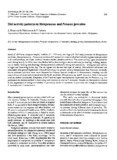Diel activity patterns in Metapenaeus and Penaeus juveniles
- Global styles
- MLA
- Vancouver
- Elsevier - Harvard
- APA
- Help
Share
Abstract
Small (5–10.9 mm carapace length), medium (11–15.9 mm), and large (16–20.9 mm) juveniles of Metapenaeus anchistus, Metapenaeus sp., Penaeus monodon and P. merguiensis were stocked individually in glass tanks provided with sand substrate, sea water, artificial bamboo shelter, aeration and food. The seven activity types (recorded for each shrimp hourly for 24 h) were classified as below (burrowing) or above substrate (swimming, walking, stationary, in shelter, feeding and cleaning). Shrimp juveniles exhibited a strong diel periodicity — emergence and activity at night and burrowing in the day. The chi-square test showed that type of activity (above/below substrate) was associated with period (light/dark). Diurnal burrowing was greater among Metapenaeus than Penaeus; inversely, above substrate activities were more frequent for Penaeus species compared to Metapenaeus. Feeding was the major above substrate and nocturnal activity for M. anchistus, Metapenaeus sp. and P. monodon. Only P. Monodon used the shelter consistently. Frequency of the 7 activity types was dependent on juvenile size for Penaeus, e.g., the preference for shelters shifted to burrowing with increase in size in P. monodon. Results are discussed in relation to the importance of mangrove habitats in providing shelter to penaeids, in particular the mangrove-associated P. monodon and P. merguiensis.
Suggested Citation
Primavera, J., & Lebata, J. (1995). Diel activity patterns in Metapenaeus and Penaeus juveniles. Hydrobiologia , 295(1-3), 295-302. https://doi.org/10.1007/BF00029136
Type
ArticleISSN
0018-8158Koleksi
- Journal Articles [1258]



